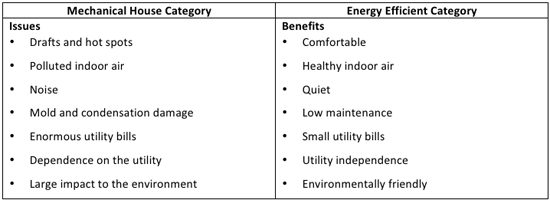First published by Greenbiz 2011-08-17 and covered by Treehugger
Part 1
 "Passive" construction is an innovative building technique that reduces energy requirements for heating, cooling and ventilating up to 80 percent. The occupants are more comfortable since a passive building provides consistent temperatures, eliminates drafts and circulates fresh, filtered air. Impressive!
"Passive" construction is an innovative building technique that reduces energy requirements for heating, cooling and ventilating up to 80 percent. The occupants are more comfortable since a passive building provides consistent temperatures, eliminates drafts and circulates fresh, filtered air. Impressive!Would You Name Your Concept "Inert" or "Inactive"?
The name passive construction is from the German passive building movement -- PassivHaus. The term "passive" is meant to convey that the building uses mostly non-mechanical methods for heating, cooling and ventilation. This is in contrast to the typical modern building where "active" mechanical systems do most of the work.
Although scientifically correct, the name "passive" creates a poor first impression with an English speaking non-technical audience. Passive is usually used when you want to describe someone or something that is submissive, inert or inactive. Not exactly a word that triggers interest. "Passive" extinguishes any thoughts of innovation or quality.
With A Poor Name, the Consumer May Tune Out Before You Can Educate
Some may think that with solid marketing a poor name can be overcome. The effort is likely to be considerable because most of us use shortcuts to manage complexity. A name is one of those shortcuts.
- Is "Jennifer" more attractive than "Gertrude"? Yes. Researchers Willis and Henderson found an attractive name makes the person seem more attractive. When showing participants unnamed photos of two attractive women, both received equal votes when asked who is "most attractive". The results changed dramatically when labeled "Jennifer" and "Gertrude." "Jennifer" was then selected 60 percent more frequently.
- Can "free" be a poor offer? Yes. The founders of "free software" movement thought they had the perfect name. But corporate and other customers were wary of a product that was free. Free software took off when it was rebranded as "open source".
- Is "Caverject" a new James Bond weapon? No, it is an injectable erectile dysfunction drug. Three years after Caverject's launch, Pfizer planned a new approach to market directly to consumers. Pfizer's customer focus paid off. The new drug was christened "Viagra."
With limited opportunity to gain the consumer's attention, why waste a marketing effort to correct a deficit that can be easily turned into an asset?
But Is Marketing Even Appropriate?
Some may find marketing distasteful since marketing has been used to hard-sell products that may be dubious at best or outright harmful for the consumer and the environment.
Philip Kotler, the father of modern marketing, explains that virtuous "Marketing is the art of creating genuine customer value. It is the art of helping your customers become better off."
The intention is to practice virtuous marketing to get more sustainable practices and products adopted. The term "passive," used in this context, requires a detailed explanation before most people get it. In the long run, poor marketing will likely hinder and great marketing will help the acceptance of passive and other green buildings.
First Things First: Define the Marketing Strategy
The name is just one part of the marketing mix and to be most effective it should complement the overall marketing strategy.
Reis & Ries advised in the marketing classic The Origins of Brands to first find weaknesses in the leading brand. Then show the consumer how the new brand is the next revolutionary step and diverges from the old category. Brands that excelled at this repositioning are:
- Starbucks robust taste diverges from regular (weak) coffee
- Mercedes / Lexus (next generation of luxury) diverges from Cadillac / Lincoln (your dad's version of luxury)
- Silk soy (nature's perfect protein) milk diverges from traditional (lactose) milk
Let's explore potential brand positions by contrasting the mechanical house --- the current standard to the energy efficient house. This exercise is to find opposing attributes.

In part 2, we will define three brand positions from the set of opposing attributes. Read more >>
Contact me to understand how to position your project for success


No comments:
Post a Comment